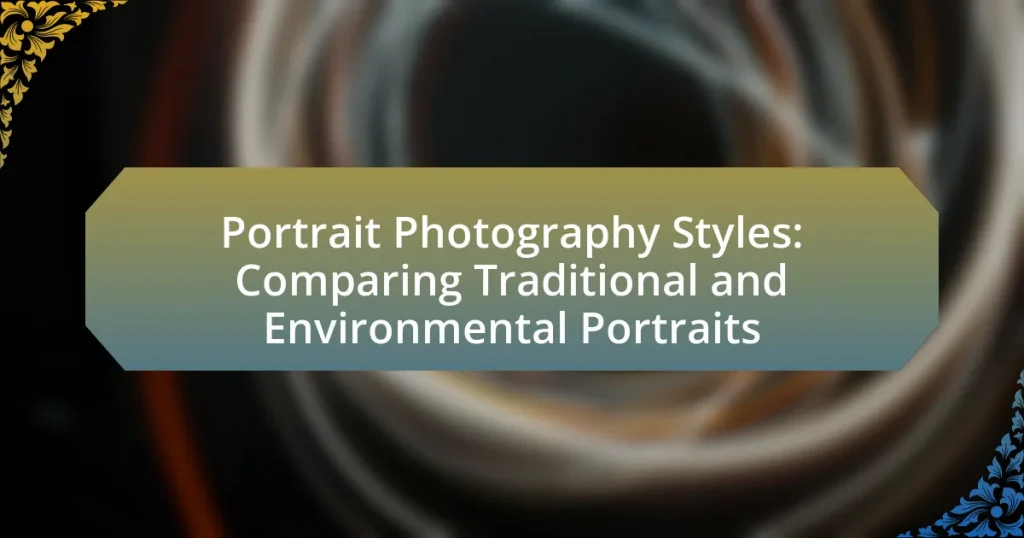The article focuses on the key differences between Traditional and Environmental Portraits in photography. Traditional portraits emphasize the subject in a controlled setting, highlighting facial expressions and attire, while Environmental portraits incorporate the subject’s surroundings to provide context and tell a story about their life or profession. The article outlines the characteristics, techniques, and practical applications of both styles, discussing how lighting, background selection, and post-processing differ between them. It also explores the emotional impact and narrative potential of each style, helping photographers choose the appropriate approach based on the subject and intended message.

What are the key differences between Traditional and Environmental Portraits?
Traditional portraits focus on the subject in a controlled setting, often emphasizing facial expressions and attire, while environmental portraits incorporate the subject’s surroundings to provide context and tell a story about their life or profession. Traditional portraits typically utilize neutral backgrounds and studio lighting, aiming for a classic aesthetic, whereas environmental portraits use natural light and the environment to enhance the narrative, showcasing the subject’s personality and lifestyle. This distinction highlights how traditional portraits prioritize formality and simplicity, while environmental portraits embrace context and storytelling.
How is Traditional Portrait Photography defined?
Traditional portrait photography is defined as a style focused on capturing the likeness and personality of an individual or group, typically in a controlled setting with an emphasis on formal poses and lighting. This genre often utilizes backdrops and studio lighting to create a polished and timeless appearance, reflecting the subject’s character and social status. Historically, traditional portrait photography has roots in the 19th century, where it became a popular means of documenting individuals, often commissioned by families or individuals seeking to preserve their legacy.
What are the common characteristics of Traditional Portraits?
Traditional portraits typically feature a clear focus on the subject, often emphasizing facial expressions and body language. These portraits are characterized by formal poses, controlled lighting, and a neutral or simple background that does not distract from the subject. Additionally, traditional portraits often utilize props or clothing that reflect the subject’s personality or status, enhancing the narrative of the image. Historically, this style has roots in classical painting, where the aim was to convey dignity and character, as seen in works by artists like Rembrandt and Vermeer.
What settings are typically used for Traditional Portraits?
Traditional portraits typically use a wide aperture setting, often around f/2.8 to f/5.6, to achieve a shallow depth of field that blurs the background and emphasizes the subject. This technique helps to isolate the subject and create a pleasing bokeh effect. Additionally, traditional portraits are commonly shot in soft, diffused lighting, such as natural light from a window or using softboxes, to minimize harsh shadows and create a flattering appearance. The use of a focal length between 85mm and 135mm is also standard, as it allows for a natural perspective and compression that flatters the subject’s features. These settings are widely recognized in portrait photography for their effectiveness in producing high-quality, visually appealing images.
What defines Environmental Portrait Photography?
Environmental Portrait Photography is defined as a style that captures subjects in their natural surroundings, emphasizing the relationship between the individual and their environment. This approach not only highlights the subject’s personality but also provides context that reflects their lifestyle, profession, or interests. For instance, a musician may be photographed in a studio filled with instruments, which adds depth to the portrayal and tells a story about their craft. This method contrasts with traditional portrait photography, which often focuses solely on the subject against a neutral background, lacking the environmental context that enriches the narrative.
How does the environment influence Environmental Portraits?
The environment significantly influences Environmental Portraits by providing context that enhances the subject’s story and character. This type of portraiture integrates the subject with their surroundings, allowing elements like location, lighting, and background to convey emotions and narratives. For instance, a portrait taken in a bustling city can reflect the subject’s lifestyle and personality, while a serene natural setting may evoke tranquility and introspection. The choice of environment can also highlight cultural or occupational aspects, as seen in portraits of artists in their studios or farmers in fields, thereby enriching the viewer’s understanding of the subject.
What are the typical subjects and themes in Environmental Portraits?
Environmental portraits typically feature individuals in their natural surroundings, emphasizing their relationship with the environment. Common themes include the subject’s profession, hobbies, or cultural background, which are often highlighted through the use of relevant settings, props, and activities. For instance, a musician may be photographed in a studio or a park, showcasing their instrument, while a farmer might be depicted in a field, illustrating their connection to agriculture. This approach not only captures the essence of the subject but also tells a story about their life and context, making the portrait more meaningful and engaging.
Why choose one style over the other?
Choosing one portrait photography style over the other depends on the desired emotional impact and context of the subject. Traditional portraits focus on the subject’s face and expressions, often using controlled lighting and backgrounds to convey a sense of formality and intimacy. In contrast, environmental portraits incorporate the subject’s surroundings to tell a story about their life or profession, providing context that can enhance the viewer’s understanding of the subject’s personality and experiences. For example, a traditional portrait may be ideal for formal occasions like graduations or corporate headshots, while an environmental portrait is more suitable for showcasing an artist in their studio or a chef in their kitchen, as it adds layers of meaning and narrative to the image.
What factors influence the choice between Traditional and Environmental Portraits?
The choice between Traditional and Environmental Portraits is influenced by the subject’s personality, the intended message of the portrait, and the context in which the portrait will be displayed. Traditional Portraits typically focus on the subject in a controlled setting, emphasizing their features and expressions, which is ideal for formal occasions or professional settings. In contrast, Environmental Portraits incorporate the subject’s surroundings, reflecting their lifestyle or interests, making them suitable for storytelling or personal branding. The decision often hinges on the desired emotional impact and narrative, as well as practical considerations like location and lighting conditions.
How do personal preferences affect the decision on portrait style?
Personal preferences significantly influence the decision on portrait style by guiding the choice between traditional and environmental approaches. Individuals often select a portrait style based on their aesthetic values, emotional connections, and the context in which they want to present themselves. For instance, someone who values classic aesthetics may prefer traditional portraits that emphasize formal poses and studio settings, while another person who appreciates storytelling and context might opt for environmental portraits that showcase their personality and surroundings. This choice is supported by studies indicating that personal identity and cultural background play crucial roles in shaping preferences for visual representation in photography.

What are the techniques used in Traditional and Environmental Portraits?
Traditional portraits primarily utilize techniques such as controlled lighting, posed subjects, and a neutral background to emphasize the subject’s features and expressions. In contrast, environmental portraits incorporate the subject’s surroundings to provide context and tell a story, often using natural light and candid poses to create a more dynamic composition. The effectiveness of these techniques is supported by the fact that traditional portraits often aim for a timeless quality, while environmental portraits seek to capture the essence of the subject’s life and personality through their environment.
What lighting techniques are commonly used in Traditional Portraits?
Traditional portraits commonly utilize three-point lighting, which includes key light, fill light, and back light. The key light serves as the primary source of illumination, typically positioned at a 45-degree angle to the subject, creating depth and dimension. The fill light, often softer and positioned opposite the key light, reduces shadows and balances the overall exposure. The back light, placed behind the subject, adds separation from the background and enhances the three-dimensional effect. This technique has been widely adopted since the early 20th century, as evidenced by the works of renowned portrait photographers like Yousuf Karsh, who effectively employed these lighting methods to create striking and memorable images.
How does natural light differ from artificial light in Traditional Portraits?
Natural light in traditional portraits is characterized by its soft, diffused quality, which creates a natural and flattering appearance on the subject’s skin. In contrast, artificial light can be harsher and more directional, often requiring modifiers to soften its impact. Natural light varies throughout the day, providing different tones and moods, while artificial light remains consistent, allowing for controlled lighting conditions. Studies show that natural light can enhance the emotional depth of portraits, as it mimics the way the human eye perceives light, making subjects appear more relatable and authentic.
What role does flash play in Traditional Portrait Photography?
Flash serves a critical role in Traditional Portrait Photography by providing controlled lighting that enhances the subject’s features and minimizes shadows. This artificial light source allows photographers to achieve a well-lit image, even in challenging lighting conditions, such as indoors or during overcast weather. The use of flash can also create a catchlight in the subject’s eyes, adding depth and vibrancy to the portrait. Additionally, flash can help separate the subject from the background, creating a more three-dimensional effect. Studies have shown that proper use of flash can significantly improve the quality of portrait images, making it an essential tool for photographers aiming for professional results.
What are the key compositional elements in Environmental Portraits?
The key compositional elements in Environmental Portraits include the subject, background, lighting, and context. The subject is typically a person placed within their environment, which provides insight into their personality or profession. The background should complement the subject and enhance the narrative, often incorporating elements that reflect the subject’s life or work. Lighting plays a crucial role in setting the mood and highlighting the subject, with natural light often preferred for its authenticity. Context is essential, as it informs the viewer about the subject’s relationship with their surroundings, making the portrait more engaging and meaningful. These elements work together to create a cohesive image that tells a story about the subject.
How does background selection impact the storytelling in Environmental Portraits?
Background selection significantly impacts storytelling in Environmental Portraits by providing context that enhances the subject’s narrative. The chosen background can reflect the subject’s personality, profession, or environment, thereby adding layers of meaning to the image. For instance, a portrait of a musician taken in a vibrant urban setting can convey their connection to the city’s culture, while a portrait of a farmer in a field emphasizes their relationship with nature and agriculture. This contextual relationship between the subject and background not only informs the viewer about the subject’s life but also evokes emotions and tells a more compelling story.
What framing techniques enhance Environmental Portraits?
Framing techniques that enhance Environmental Portraits include the use of natural frames, leading lines, and depth of field. Natural frames, such as doorways or branches, draw attention to the subject while integrating the environment, creating a cohesive image. Leading lines guide the viewer’s eye toward the subject, emphasizing their connection to the surroundings. Additionally, a shallow depth of field can isolate the subject from the background, highlighting their role within the environment while still providing context. These techniques are supported by photographic principles that emphasize composition and viewer engagement, making Environmental Portraits more impactful.
How do post-processing techniques differ between the two styles?
Post-processing techniques in traditional and environmental portrait photography differ primarily in their focus and application. Traditional portrait photography often emphasizes skin retouching, color correction, and background enhancement to create a polished, studio-like appearance. In contrast, environmental portrait photography prioritizes the integration of the subject with their surroundings, often employing techniques that enhance the natural lighting and textures of the environment, while maintaining a candid feel. This distinction is evident as traditional portraits may utilize more extensive editing software features to achieve a flawless look, whereas environmental portraits may focus on preserving the authenticity of the scene, resulting in minimal adjustments to maintain the natural ambiance.
What editing styles are preferred for Traditional Portraits?
Preferred editing styles for Traditional Portraits include classic retouching, soft focus, and natural color grading. Classic retouching enhances skin tones and smooths imperfections while maintaining a natural look, which is essential for traditional portraiture. Soft focus adds a gentle blur that creates a dreamy effect, often used to evoke a sense of nostalgia. Natural color grading ensures that the colors remain true to life, preserving the authenticity of the subject. These styles are widely recognized in portrait photography for their ability to highlight the subject’s features while maintaining a timeless quality.
How does post-processing enhance the narrative in Environmental Portraits?
Post-processing enhances the narrative in Environmental Portraits by allowing photographers to manipulate elements such as color, contrast, and sharpness to better convey the subject’s relationship with their environment. This technique can highlight specific details that tell a story about the subject’s lifestyle, emotions, or context, making the image more engaging and informative. For instance, adjusting the color saturation can evoke certain moods, while enhancing sharpness can draw attention to significant background elements that contribute to the overall narrative. Studies have shown that well-executed post-processing can significantly impact viewer perception, making the narrative more compelling and relatable.

What are the practical applications of Traditional and Environmental Portraits?
Traditional and Environmental Portraits have practical applications in various fields, including personal branding, marketing, and storytelling. Traditional Portraits are often used for formal occasions such as family portraits, graduation photos, and professional headshots, providing a classic representation of individuals. Environmental Portraits, on the other hand, capture subjects in their natural surroundings, making them ideal for showcasing a person’s profession, hobbies, or lifestyle, which enhances narrative depth. For instance, a photographer might capture a chef in their kitchen or an artist in their studio, effectively communicating their identity and context. This approach not only personalizes the subject but also engages viewers by providing a richer visual story.
In what scenarios are Traditional Portraits most effective?
Traditional portraits are most effective in formal settings, such as family gatherings, professional headshots, and milestone celebrations like graduations or anniversaries. These scenarios benefit from the classic composition and controlled lighting that traditional portraits offer, emphasizing the subject’s features and expressions. The structured approach of traditional portraiture captures the essence of the moment, making it ideal for preserving memories in a timeless manner. Additionally, traditional portraits are often used in official contexts, such as corporate environments, where a polished and professional image is required to convey authority and credibility.
How are Traditional Portraits used in professional settings?
Traditional portraits are used in professional settings primarily for branding and personal representation. In corporate environments, these portraits often serve to establish a professional image for employees, enhancing credibility and trustworthiness. For instance, many companies display traditional portraits of executives in their offices to convey authority and professionalism. Additionally, traditional portraits are commonly utilized in official documents, such as company websites and press releases, to create a consistent and polished visual identity. This practice is supported by research indicating that visual representation significantly influences first impressions and perceptions of competence in professional contexts.
What role do Traditional Portraits play in family and personal photography?
Traditional portraits serve as a vital means of capturing and preserving family and personal identities. They provide a formal representation of individuals, often highlighting relationships and milestones within a family context. Traditional portraits are characterized by their posed nature, which allows for careful composition and attention to detail, ensuring that the subjects are presented in a flattering and meaningful way. This style of photography has historical significance, as it has been used for centuries to document lineage and heritage, reinforcing familial bonds and creating a visual legacy that can be passed down through generations. The emotional connection fostered by these portraits contributes to their enduring role in family and personal photography, as they evoke memories and narratives that are central to individual and collective identities.
What are the benefits of using Environmental Portraits in storytelling?
Environmental portraits enhance storytelling by providing context that reveals the subject’s personality and environment. This style captures individuals in their natural surroundings, allowing viewers to gain insights into their lives, interests, and emotions. For instance, a portrait of a musician in their studio not only showcases their face but also conveys their passion and creative space, enriching the narrative. Studies in visual communication indicate that images with contextual backgrounds are more engaging and memorable, as they create a deeper connection between the subject and the audience.
How do Environmental Portraits convey a subject’s personality and context?
Environmental portraits convey a subject’s personality and context by integrating the individual with their surroundings, which reflect their lifestyle, interests, and emotional state. This style of photography captures not only the subject but also elements of their environment, such as objects, colors, and settings that are significant to them. For instance, a musician photographed in their studio surrounded by instruments illustrates their passion and profession, providing viewers with insights into their identity. Research indicates that environmental portraits can evoke a deeper emotional connection, as the context enhances the narrative of the subject, making the image more relatable and engaging.
What industries benefit from Environmental Portrait Photography?
Environmental Portrait Photography benefits several industries, including corporate, healthcare, education, and creative sectors. In the corporate industry, companies utilize environmental portraits to showcase their employees in relatable settings, enhancing brand identity and trust. The healthcare sector employs this style to humanize medical professionals, fostering a connection with patients. Educational institutions use environmental portraits to highlight faculty and student interactions, promoting a vibrant learning environment. Additionally, the creative industry, including artists and designers, leverages environmental portraits to convey their artistic vision and personal brand in context. These applications demonstrate the versatility and impact of environmental portrait photography across diverse fields.
What tips can help photographers choose the right style for their projects?
Photographers can choose the right style for their projects by first identifying the subject and purpose of the shoot. Understanding whether the focus is on capturing personality, emotion, or context will guide the selection between traditional and environmental portrait styles. For instance, traditional portraits emphasize controlled settings and lighting to highlight the subject, while environmental portraits incorporate surroundings to tell a story about the subject’s life or interests.
Additionally, photographers should consider their audience and the message they want to convey. Research indicates that portraits that resonate with viewers often align with their expectations and cultural context. For example, a study published in the Journal of Visual Culture highlights that environmental portraits can evoke a sense of connection and relatability, making them effective for personal branding.
Lastly, experimenting with different styles through practice and feedback can refine a photographer’s ability to choose the most suitable approach for each project.















